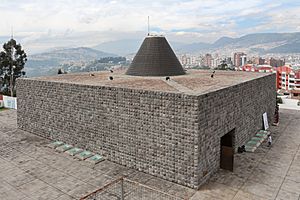Oswaldo Guayasamín facts for kids
Oswaldo Guayasamín (born July 6, 1919 – died March 10, 1999) was a famous Ecuadorian painter and sculptor. He had roots from the Kichwa and Mestizo cultures.
Contents
Who Was Oswaldo Guayasamín?
His Early Life and Artistic Beginnings
Oswaldo Guayasamín was born in Quito, Ecuador. His father was a native Kichwa man, and his mother was a Mestiza woman, also of Kichwa background. His family was not rich. His father worked as a carpenter for many years. Oswaldo himself worked as a taxi and truck driver when he was younger. He was the oldest of ten children.
Even as a child, Oswaldo loved to draw. He would sketch funny pictures of his teachers and friends. He showed a strong passion for art from a very young age. He later created art that spoke about human and social problems across the Americas, which became famous worldwide.
He studied at the School of Fine Arts in Quito. There, he learned to be a painter and a sculptor. He also studied architecture. His first art show happened in 1942 when he was 23 years old. A sad event happened while he was in college: his best friend died during a protest in Quito. This event deeply affected him and later inspired one of his paintings, Los Niños Muertos (The Dead Children). This tragedy also helped him see the world and society in a powerful new way.
Oswaldo's Amazing Art Career
Guayasamín started painting when he was just six years old. He loved to draw from that age. His art journey began with watercolors and grew into his unique style, focusing on human feelings and struggles. While sad events shaped his work, his friend's death especially pushed him to paint strong symbols of truth and unfairness in society. Even before he could read, he was already selling his artwork. After attending the School of Fine Arts, his career truly took off.
One of the first places to show Guayasamín's art was La Galería Caspicara. This art gallery was opened by Eduardo Kingman in 1940. Guayasamín's art stood out because it showed the struggles of people in lower social classes. This helped him gain more attention. A painting called El Silencio (The Silence) was especially important from this show. It marked a change in his art. Instead of just telling stories, his subjects began to represent all human suffering.
From 1942 to 1943, Guayasamín traveled in the United States and Mexico. There, he met another famous artist, José Clemente Orozco. They traveled together to many countries in South America, including Peru, Brazil, Chile, Argentina, and Uruguay. Through these trips, he saw more of the lives of native people and the poverty they faced. These observations often appeared in his paintings.
In 1988, the government of Ecuador asked Guayasamín to paint a large mural. This mural was meant to show the history of Ecuador. One part of the painting caused some discussion. It showed a figure in a Nazi helmet with "CIA" written on it. This part was criticized by the United States Government.
Oswaldo Guayasamín won many important awards for his art. In 1948, he won first prize at the Ecuadorian Salón Nacional de Acuarelistas y Dibujantes. He also won first prize at the Third Hispano-American Biennial of Art in Barcelona in 1955. In 1957, he was named the best South American painter at the Fourth Biennial of São Paulo.
His last art shows were in Paris, France, and Buenos Aires, Argentina, in 1995. Guayasamín also built a museum in Quito that displays his artwork. His paintings often show political unfairness, racism, poverty, and the differences between social classes in South America.

Guayasamín spent his life painting, sculpting, and collecting art. He was a strong supporter of the Cuban Revolution and its leader, Fidel Castro. He received an award from UNESCO for his "entire life of work for peace." His death on March 10, 1999, was a great loss for Ecuador. It happened during a difficult time for the country, with protests by native people and others whom he had supported throughout his life. He is still seen as a national hero.
In 2002, three years after he passed away, a special building called La Capilla del Hombre ("The Chapel of Man") was finished and opened to the public. Guayasamín helped design this building. The Chapel is meant to show both the bad things humans do to each other and the amazing potential for good within humanity. It is located near Guayasamín's home, on a hill overlooking Quito.
See also
 In Spanish: Oswaldo Guayasamín para niños
In Spanish: Oswaldo Guayasamín para niños
Images for kids



